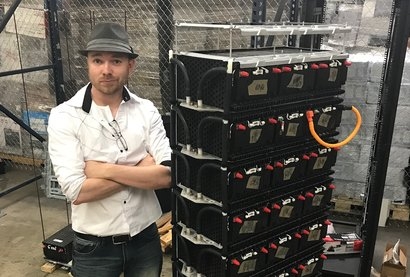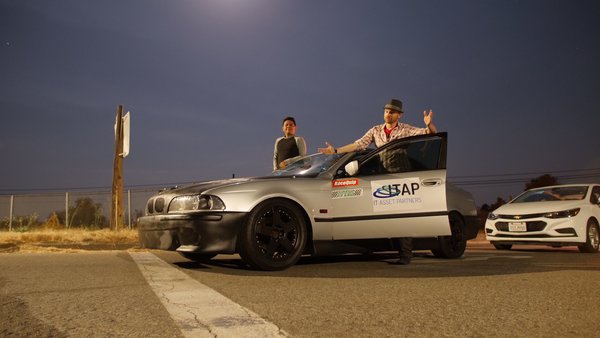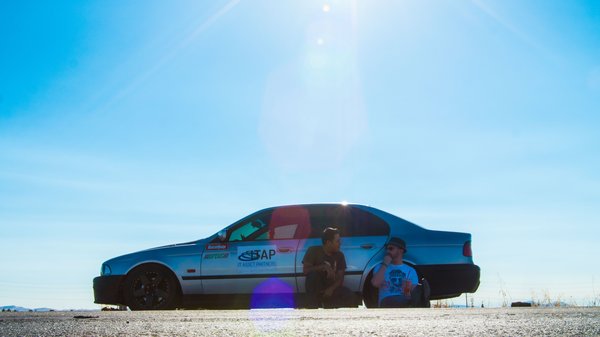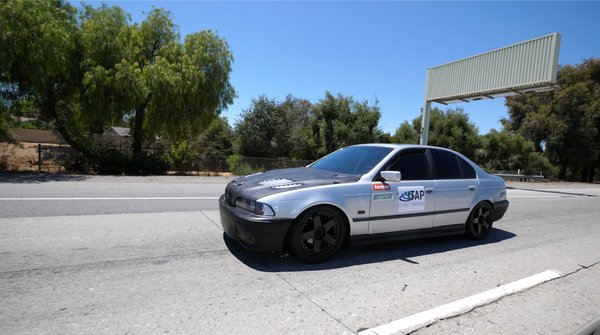
Eric Lundgren will be attempting to break Tesla's Guinness book of world Records “Longest Range for an Electric Vehicle” by driving his self-built electric car, the Phoenix, over 1,000 miles on a single charge at ‘The Auto Club Speedway’ in Los Angeles on Oct. 16 & 17th. The world’s press picked up the story last month that a Tesla's Model S drove for 670 miles on a single charge, but Lundgren’s team are confident they can blow that record out of the water.
Never before has a non-solar electric car travelled over 1,000 miles on a single charge, much less a vehicle that has been built from 90 percent old recycled trash. The car cost less than $14,000 to build and has already beat the Tesla P100Dm, Nissan Leaf, Chevy Bold and Fiat 500e cars combined mileage.
Mr Lundgren’s aim is to demonstrate the principle of ‘hybrid recycling’, helping to show the world what is possible with electric vehicles. Electronic Waste is the fastest growing waste stream in the United States, yet the country lacks a real solution to efficiently process this waste system. Most e-Waste is sent to a landfill at financial costs and to the detriment of the environment, while other e-Waste is exported to third-world countries where inhumane processing methods lead to wide-spread injury and death. Through efficiency and innovation, Lundgren’s company identifies all generic parts and components of value and preserves discarded e-waste, rather than just destroying them. The company then extracts and re-integrates the e-Waste into new applications. This ‘hybrid recyling’ decreases the demand for raw material production, conserving natural resources and reducing the carbon footprint.
REM talked to Mr Lundgren to find out about the Phoenix and to learn just how much better than currently commercially available models an electric vehicle can really be.

Can you tell me a bit about yourself and your expertise?
I grew up in a very small town, on a farm, and at a young age I went to the local bank and they were recycling their computers. I asked them what they were doing with their computers and if they were looking for a recycler. In my small town there’s only one bank and one barber shop and no recycler, so I said I was a recycler and so became one. That was at the age of 15 and by 19 I was recycling for all the American airlines in the United States. By 20 I was running a very large recycling company called ECA (Environmental Computer Associates).
I realised that recycling was missing a step. If it’s a commodity, copper or aluminium or steel, we know what to do with that, as we’ve been recycling that material for a very long time. When it comes to electronics or ‘e-waste’, which is the largest growing waste stream in the world, we don’t know how to recycle it, and the companies that are recycling e-waste are not doing so in the most efficient manner. We try to figure out how to reuse the whole unit, and if we can’t because a part is broken, usually that part is proprietary and so we just scrap the unit. We recycle everything for its commodity value, but that is like lowering everything down to the lowest common denominator of value. In other industries we don’t do this.
If I need to scrap my car for example, I can still sell the car who’s going to use the parts and components, but in the electronics industry, if you smash your phone, it doesn’t go down that route. So in the US, I realised there were no solutions to these problems and so I decided to go to China, where they were buying up all of our waste. I literally sold some electronic waste and followed it to China. I realised they were extracting all the parts and components and were building new things out of them. They were taking batteries out of old phones, putting them in cases and they became external chargers for new phones. They were taking old laptop batteries out and making new laptop batteries. I realised that when you open up all the electronics today, 90 percent of what’s inside is generic, it isn’t proprietary. I just watched as they were reusing all these parts in China and I thought we could do this in America.
I took the best solutions they had. Some of them weren’t environmentally friendly, but I took the best ones they had, brought them back to the US and partnered with the Environmental Protection Agency (EPA), helped to create R2, the certification in the US for electronic recycling and repair, and started figuring out a new type of recycling that we call ‘hybrid recycling’.

What is Hybrid Recycling?
Hybrid recycling is the reuse of parts and components for electronics. If you open up something that looks proprietary, it’s made up of all the nuts and bolts that are generic that you can reuse in thousands of other applications. So we started taking old electric vehicle batteries and turned them into new e-wheelchairs and started taking old solar panels and recutting them and turning them into new micro-solar panel arrays that allows a family in Cambodia to stop burning kerosene by simply putting a 25 watt panel on their roof. Inside we have the same light that is fitted on to the back of your phone right now, which is very, very efficient, that can be used as a light source. This allows families in Cambodia to stop using kerosene, which is a harmful carcinogen, and empowers them to charge their cellphone and have light for free and save a very large part of what used to be spent on kerosene. We’re all about empowering people with waste.
Can you tell me about The Phoenix and the technology it uses?
When I reached out to a whole load of reporters and tried to explain hybrid recycling and it didn’t get a lot of traction. So I asked a friend of mine in the media industry and he told me that people want a demonstration. Don’t just explain it and talk about it, but show it. I wanted a demonstration on the macro level, to really demonstrate what hybrid recycling is, so I decided to build a car out of trash, out of consumer waste. I wanted that car to be a world-record setting car. I wanted it to be better than the latest technology. I wanted to show that you can take 10-year old parts and apply them in a new format and create something that is better than the best technology that exists today.
So we built the Phoenix in 40 days. The car itself was dragged out of a junkyard. The batteries came out of a lot of different types of broken electronics. The controller came out of a 10-year old forklift. The entire car, or 90 percent of the car by weight came out of a junkyard or out of my recycling facility. We wanted this car to beat the Tesla on its range. Range is something practical and a problem that we all face today. I bought an electric car when they first came out and I also bought one last year. These two vehicles came out seven years apart and they both have the same range. I bought a BMW i3 and I can’t take it to the beach and back, which is about 45 miles away. Range is a problem that everyone who has an electric vehicle worries about and those who don’t have an electric vehicle don’t buy one because they are worried about range anxiety. We decided to attack that problem.
When we first built the car, on its maiden voyage, we put it up against a Tesla Model S P90D. We didn’t expect it to win, we were just curious to see how far it would go. It went 384 miles. It was its first time around the block, we hadn’t even ran this thing before.
After calibrating the car, working on it for another week, we did a second voyage, which this time was a ‘real world’ road trip, from Chatsworth, California, my headquarters, up to Sacramento, the state capital, and then from Sacramento over to San Francisco, driving by Apple and Tesla, and the vehicle went for 748 miles, on a single charge. It was a real eye-opener to me that you could build an electric car, in 40 days, that travels three times the distance than the best electric car that is currently out there on the market. The Tesla followed us, and we had to stop twice so that it could recharge overnight.
I love Tesla. This is not about wanting to compete with any vehicle manufacturer. This entire project is about educating people on hybrid recycling. The vehicle is an educational tool. It shows that your ‘waste’ is not waste. It shows that there is value in what we throw away. I want people to view what they throw away differently. I want people to think “Maybe that’s reusable. Maybe I can find another use for that”, whatever it is they are about to throw away. And if not, I want them to work with hybrid recyclers so that if they are not in that industry, at least they can give it to someone who is going to use that item, rather than just shredding everything.
We live in a society where we mine all these materials, build all these amazing creations, and then someone drops it or it gets water damaged and then someone trashes it and it goes back into the dirt, where it leaves harmful chemicals leaching into our water table, like lead and mercury and bromine and cadmium, and then someone drinks that water and gets sick.
Can you tell me a bit more about the technology?
The batteries are lithium ion, in a 165 kilowatt hour battery pack. The motor is an AC50 motor, the controller is a 4339 controller, the body is a 1997 BMW 528i, the frame is an E39 frame, basically everything about this car, you could go to the store or to your local hardware store and buy.
We’re doing one final run in this car. We’re going to take it over to a local 2-mile speedway track, the Autoclub Speedway, the only 2-mile track in California. We’re going to take it over there and do a hyper mileage test, basically taking it around the track to see how far we can go. I am predicting that it’s going to go 1200 miles. There will be 20 drivers and it will be live on youtube for the entire run, over two days and two nights straight. Once again, it’s just to educate people as to what’s possible for electric vehicles, what’s possible for batteries and what’s possible for people’s trash. Right after this, I will open the doors to all the technology, because I want people all over the world to have the option of building their own electric car, for $13,800 (£10,477), that’s what mine cost. That’s one-tenth the price of Tesla, that’s with a back seat, so you can take the family. I hope someone then goes out and builds one.
It isn’t about making money, it’s about educating the world and sharing what’s possible. Hopefully they can take it farther than I have, maybe 1600 miles on a single charge. It’s not just about the range though, but also about the efficiency – powering a vehicle so that it’s extremely efficient. The vehicle we have today can go from Los Angeles to Las Vegas for $13.53. It can travel from Los Angeles to New York for $122. It’s about how energy efficient the vehicle is, compared to gasoline, and the energy cost. When I open the schematics, I hope that not only people build these but build them better.

When you say ‘people’, do you mean ordinary people, or do you mean vehicle manufacturers? Because a lot of people, rather than build their own, will want to just go to the showroom, buy one and drive off with it.
I would say both. I want to inspire the DIY guys of the world to pick up their tools and go ahead and build. The people who can’t afford an electric vehicle, I want them to know they can build one better. Take the shell off any electric vehicle and what you are going to find is battery technology that’s been around for seven years, motor technology that’s been around for twelve years, controller technology that’s been around for ten years. I want to inspire the DIY guys, but also want the consumers of the world to understand what’s possible and start requesting this. A lot of the vehicle manufacturers in the US are building vehicles that go 100 miles on a charge – BMW, Honda, Ford, etc. Up until last year, all of their vehicles went 100 miles. How is it that I can create one that goes 748 miles? Driving up mountains and in real world driving conditions. I want consumers to start demanding what’s possible.
Battery technology has come leaps and bounds in laptops etc and now its in cars. The energy density is there now. We can now compete with the Internal Combustion Engine (ICE). We can compete with gasoline powered cars. We can build electric cars that are better than gasoline powered cars in every way. Do I want to build cars? No. Do I want the electric vehicle industry to start building electric cars that people want to drive? Yes. Do I want people to start looking at their waste and figuring how to reuse it properly? Yes. Do I want electronics to end up in landfills that are really meant for organics? No.
I am an environmentalist, but there are many others out there that want to consolidate the consumption. I don’t believe in that. I believe that we should be able to lead a life of absolute abundance, as long as we retain our waste and process it correctly. I believe that we should be able to buy more products, faster, that are cheaper, because they are made with all the parts from the older products. I don’t believe that we should have to continue to mine for aluminium and copper and all these precious metals and then put them into something that we’re just going to use for a year and throw away in a hole. I believe if we start hybrid recycling, we can achieve a world of abundance.
What kind of interest have you had in this?
I came back to the US five years ago and founded a company called IT Asset Partners (ITAP) and we have started recycling for twelve of the largest Fortune 500 companies in America. We are able to give them exponentially more revenue for their waste stream. We’re able to offer them something that is much more important than the financial gain, meeting the zero landfill policy. I have reached out to electric vehicle manufacturers and started recycling for some of the largest automobile manufacturers in the world. I recycle for the largest computer company in the world, Renovo, as of three years ago. I recycle for the largest gaming company in the world – Nintendo. I really hope that people start copying my solutions, because its good for the world if we all start recycling.
For additional information:

